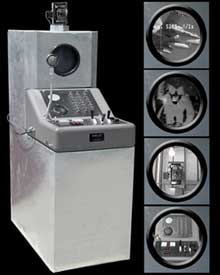 The ’50s-style look of the DEFENDEX-ESPGX as well as its content bring about implied comparisons between the fearful culture of the Cold War and the culture of fear associated with the current War on Terror.
The ’50s-style look of the DEFENDEX-ESPGX as well as its content bring about implied comparisons between the fearful culture of the Cold War and the culture of fear associated with the current War on Terror.
The device has a familiarity of a past era in which technologies were seemingly simpler and less abstract. Users understand how to use the controls of DEFENDEX-ESPGX even though they are not aware of the virtual system behind the interface.
The device also performs surveillance functions, grabbing control data and content from an external video camera and microphone. Users control the surveillance device while being watched at the same time. In order to watch you must be watched.
The source material includes pre-recorded political, military, and other footage, as well as audio and video streamed from the sensor space. Users can navigate 3 modes of “narrative terrain”: an action mode, a consequence mode, or a narrative mode. In an action mode the user must complete tasks to move to the next mode. After successful completion of tasks, the user might move to a consequence mode where the ramifications of their actions become apparent. Otherwise, the user is taken to a narrative mode consisting of playback of prerecorded media, which delivers clues as to the secrets behind the DEFENDEX-ESPGX. Progress through the modes does not occur in a linear fashion. The current mode does not necessarily predetermine the next mode. The route for each user will be unique.
By John Thompson and MarkDavid Hosale. Part of ISEA 2006, San José.
